SIMPLIS Parts
|
The Shift Register (Multi-bit) models a combination of a clocked data type register and a shift register which can shift multiple bits on a clock edge. When the register is left shifting, the LSBs shifted into the register are controlled by the LFILL pin; during a right shift, the MSBs shifted into the register are controlled by the RFILL pin. The set and reset inputs can be either asynchronous or synchronous, depending on the Set/Reset Type parameter. The active logic level of the inputs can be configured with the Set/Reset Level and Load/Shift Level parameters.
For the multi-bit shift register with either asynchronous or synchronous set and reset inputs, see Shift Register (Multi-bit) with both Async and Sync Set/Reset.
Related topics:
In this Topic Hide
Model Name: |
Shift Register (Multi-bit) |
|
Simulator: |
|
This device is compatible with the SIMPLIS simulator. |
Parts Selector |
Digital Functions | Registers |
|
Symbol Library: |
None - the symbol is automatically generated when placed or edited. |
|
Model File: |
None - the device model is generated before simulation. |
|
Subcircuit Name: |
|
|
Symbol: |
|
|
Multiple Selections: |
Only one device at a time can be edited. |
|
To configure the multi-bit shift register, follow these steps:
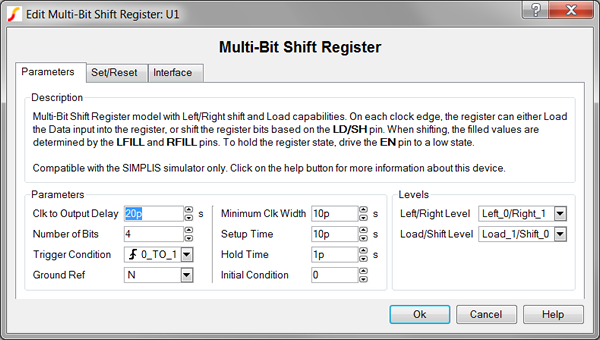
| Label | Parameter Description |
Clock to Output Delay |
|
Number of Bits |
Number of input and output bits for the multi-bit shift register |
Trigger Condition |
Determines the triggering condition of the multi-bit shift register clock pin:
|
Ground Ref |
Determines whether or not a device has a ground reference pin. |
Minimum Clock Width |
Minimum valid clock width. Clock widths less than this parameter will not trigger the multi-bit shift register. |
Setup Time |
|
Hold Time |
|
Initial Condition |
Initial condition of the multi-bit shift register output in decimal |
Left/Right Level |
Determines the logic level of the multi-bit shift register left/right (L/R) pin:
|
Load/Shift Level |
Determines the logic level of the multi-bit shift register load/shift (LD/SH) pin:
|
To define the set/reset behavior of the shift register, follow these steps from the Shift Register (Multi-bit) dialog box:
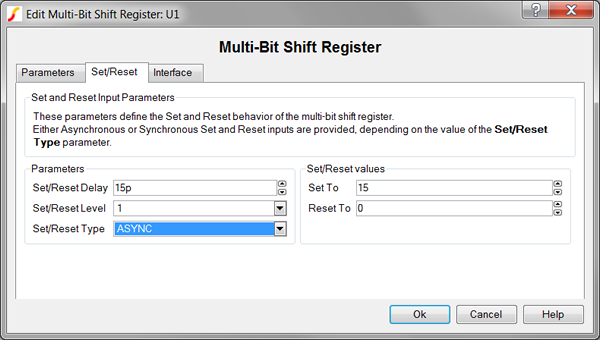
| Label | Parameter Description | ||||||
Set/Reset Delay |
Delay from when the set or reset pin goes active until the output is actually set or reset. The Set/Reset Delay is used only for asynchronous set/reset. Registers with synchronous set/reset use the Clock to Output Delay. |
||||||
Set/Reset Level |
|
||||||
Set/Reset Type |
|
||||||
Set To |
Determines the multi-bit shift register output value when the set pin goes active |
||||||
Reset To |
Determines the multi-bit shift register output value when the reset pin goes active |
To define the parameters for the interface between this digital component and each analog component connected directly to an input or output pin, follow these steps from the Shift Register (Multi-bit) dialog box:
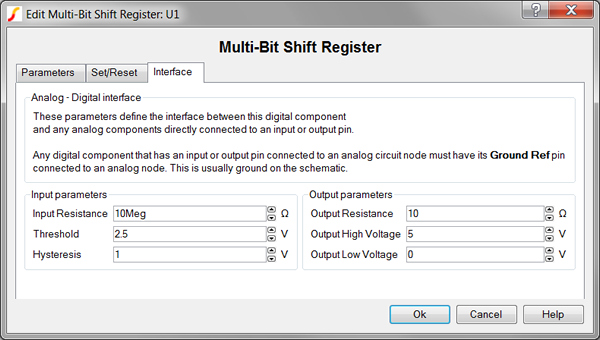
| Label | Parameter Description | |||||||
Input Resistance |
Input resistance of each input pin |
|||||||
Threshold Hysteresis |
|
The Threshold (T) and Hysteresis (H) of the Schmitt trigger input buffer on each Register input. To determine the low-to-high threshold (TH) and the high-to-low threshold (TL), substitute Threshold (T) and Hysteresis (H) in each of the following formulas :
|
||||||
Output Resistance |
||||||||
Output High Voltage |
||||||||
Output Low Voltage |
||||||||
The two truth tables below show the logic behavior with asynchronous and synchronous set/reset.
The following truth table assumes these parameter values:
When the EN input is high, and the Load/Shift Level=Load_1/Shift_0, the register will load the D input when the LD/SH pin is high, and shift the Q output when the LD/SH pin is low.
Inputs |
Output |
Action |
|||||||
LD/SH |
SET |
RST |
EN |
L/R |
LFILL |
RFILL |
CLK |
Q |
|
0 |
0 |
0 |
 |
Last Q |
Retain state |
||||
1 |
0 |
0 |
1 |
 |
Data input |
Load data |
|||
0 |
0 |
0 |
1 |
0 |
0 |
 |
Q = Last Q shifted left SC bits, fill LSBs with 0's. |
Shift left |
|
0 |
0 |
0 |
1 |
1 |
0 |
 |
Q = Last Q shifted right, fill MSBs with 0's. |
Shift Right |
|
0 |
0 |
0 |
1 |
0 |
1 |
 |
Q = Last Q shifted left, fill LSBs with 1's. |
Shift left |
|
0 |
0 |
0 |
1 |
1 |
1 |
 |
Q = Last Q shifted right, fill MSBs with 1's. |
Shift Right |
|
1 |
0 |
Asynchronous Set To value |
Asynchronous set |
||||||
0 |
1 |
Asynchronous Reset To value |
Asynchronous reset |
||||||
1 |
1 |
Last Q |
Illegal concurrent ASET and ARST |
||||||
The following truth table assumes these parameter values:
When the EN input is high and the Load/Shift Level=Load_1/Shift_0, the register will load the D input when the LD/SH pin is high and shift the Q output when the LD/SH pin is low.
Inputs |
Output |
Action |
|||||||
LD/SH |
SET |
RST |
EN |
L/R |
LFILL |
RFILL |
CLK |
Q |
|
0 |
0 |
0 |
 |
Last Q |
Retain state |
||||
1 |
0 |
0 |
1 |
 |
Data input |
Load data |
|||
0 |
0 |
0 |
1 |
0 |
0 |
 |
Q = Last Q shifted left SC bits, fill LSBs with 0's. |
Shift left |
|
0 |
0 |
0 |
1 |
1 |
0 |
 |
Q = Last Q shifted right, fill MSBs with 0's. |
Shift Right |
|
0 |
0 |
0 |
1 |
0 |
1 |
 |
Q = Last Q shifted left, fill LSBs with 1's. |
Shift left |
|
0 |
0 |
0 |
1 |
1 |
1 |
 |
Q = Last Q shifted right, fill MSBs with 1's. |
Shift Right |
|
1 |
0 |
 |
Synchronous Set To value |
Synchronous set |
|||||
0 |
1 |
 |
Synchronous Reset To value |
Synchronous reset |
|||||
1 |
1 |
0 |
0 |
Last Q |
Illegal concurrent SET and RST |
||||
The test circuit used to generate the waveform examples in the next section can be downloaded here: simplis_054_shiftregmbitsoas_example.zip.
To simulate this design, follow these steps:
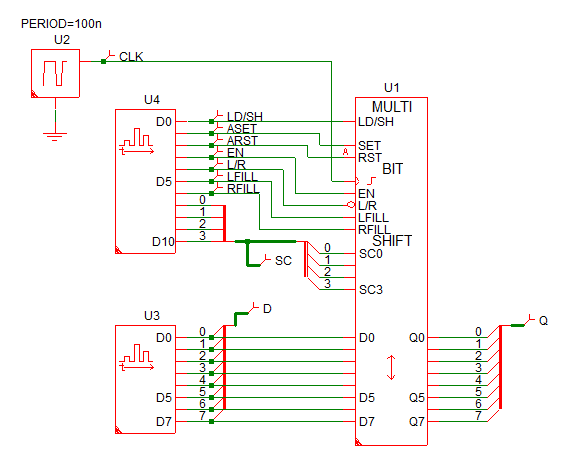
This example of the multi-bit shift register uses two Digital Signal Sources to generate the input pulses to the multi-bit shift register. The input source waveforms are defined in a text file with each state transition defined on a single line. These two sources excite every state transition in the truth table.
For clarity, the simulation waveforms taken from the circuit example have been divided into two sections.
The image below shows the load and shift behavior of the multi-bit shift register. The initial condition of the multi-bit shift register (is set to 255 decimal in the example.
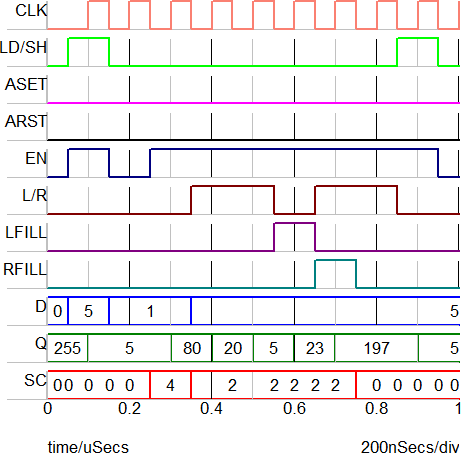
| Time | Event | Q Output (binary) |
100n |
Load | 0000 0101 |
200n |
Retain state | 0000 0101 |
300n |
Shift left 4 places | 0101 0000 |
400n |
Shift right 2 places | 0001 0100 |
500n |
Shift right 2 places | 0000 0101 |
600n |
Shift left 2 places, fill with 1's | 0001 0111 |
700n |
Shift right 2 places, fill with 1's | 1100 0101 |
900n |
Load | 0000 0101 |
The image below shows the set/reset behavior of the Register.

| Time | Event | Q Output |
1.3u |
Load | 5 |
1.52u |
Asynchronous set | 200 |
1.62u |
Asynchronous reset | 1 |
1.7u |
Load | 5 |
1.82u |
Illegal concurrent ASET and ARST | 5 |
Because the multi-bit shift register model is generated by a template script when the simulation is executed, a fixed model cannot be inserted into a netlist. The template script for this device is simplis_make_register_model.sxscr, which you, as a licensed user, can download in a zip archive of all built-in scripts.
To download this zip file, follow these steps:
Note: You will be prompted to log in with the user name and password given to you when you registered.